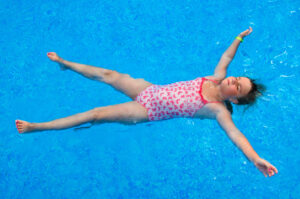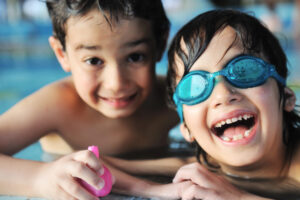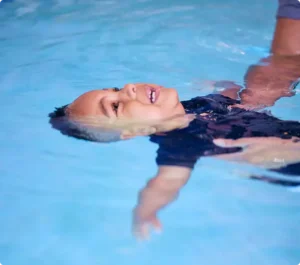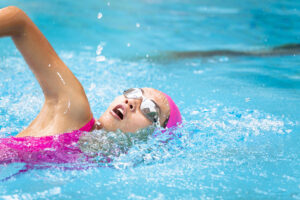Improve Your Speed and Endurance in the Pool with These Swimming Strokes
Swimming is a fun recreational activity and a valuable life skill with many physical and mental benefits. In fact, you don’t have to be Olympics-bound to learn the different swimming strokes!
Mastering each swimming stroke is essential to becoming a confident, proficient swimmer. So, let’s dive into the four main swimming strokes—freestyle, backstroke, breaststroke, and butterfly—and provide beginners like you with valuable tips to improve your technique.
With a solid understanding of these basic swimming strokes, you’ll be ready to conquer the pool and enjoy the water to the fullest.
Are you ready to master the art of these four swimming strokes?
Freestyle
The freestyle stroke, or “front crawl,” is the most popular and efficient swimming stroke.
Follow these simple steps:
Body Position
-
- Start by lying face down in the water with your body in a straight line.
- Keep your head in line with your body, looking downward.
- Keep your body close to the surface of the water.
Hand Entry
-
- Extend one arm forward, aiming for a hand entry slightly in front of your head.
- Enter the water with your fingertips first, followed by your hand and forearm.
- Keep your hand relaxed and your fingers slightly cupped.
Catch and Pull
-
- As your hand enters the water, initiate the catch phase immediately. Do this by angling your hand slightly downward to catch the water and to generate propulsion.
- Pull your arm back sweepingly, keeping your elbow high and your forearm vertical.
Arm Recovery
-
- After the pull, lift your elbow out of the water, leading with your forearm.
- Swing your arm forward and out of the water.
- Keep your arm relaxed during the recovery phase.
Body Rotation
-
- Initiate the rotation of your body as you pull with each arm.
- Rotate both your hips and shoulders to the side, allowing your arm to reach further.
Leg Kick
-
- As one arm enters the water, begin the leg kick.
- Keep your legs relatively straight and close together.
- Generate power by kicking from your hips. This is called a “flutter kick.”
Breathing
-
- Breathe to the side by turning your head during recovery.
- Exhale underwater and inhale quickly when your mouth is clear of the water.
- Aim to take a breath every two or three strokes for efficiency.
Timing and Coordination
-
- Coordinate the movement of your arms, legs, and body rotation.
- Ensure your arms and legs work together in a rhythmic motion.
- Practice maintaining a steady and efficient stroke tempo.
Practice and Technique
-
- Regularly practice the freestyle stroke to improve your efficiency and speed.
- Focus on maintaining a streamlined body position and a smooth, continuous motion.
- Seek feedback from a qualified swimming coach to refine your technique.
Freestyle is an excellent stroke for building cardiovascular fitness and improving body strength.
Backstroke
This stroke is similar to freestyle, but as the name indicates, you perform the backstroke on your back.
Follow these simple steps:
Body Position
-
- Begin by floating on your back.
- Keep your body relaxed and in a horizontal position.
- Keep your face upward, looking at the ceiling or the sky.
Arm Movement
-
- Start with your arms extended straight above your head.
- Move your arms simultaneously in a continuous alternating motion.
- Pull your arm down toward your hip, keeping it slightly bent.
- Recover your arm by lifting it from the water, reaching back above your head.
Leg Kick
-
- Perform a flutter kick with your legs, alternating up and down.
- Keep your legs relatively straight, with loose ankles and pointed toes.
- Kick from your hips and thighs, not just from your knees.
Body Rotation
-
- Coordinate your arm and leg movements with your body rotation.
- Rotate your body from side to side, like a rolling motion.
- Initiate the rotation from your hips. Let it flow through your shoulders.
Head Position
-
- Keep your head still and in line with your body.
- Look straight up at the ceiling or the sky while swimming.
- Avoid tilting your head backward or sideways.
Breathing
-
- Breathe rhythmically by rotating your body to the side.
- Take a breath every other arm stroke or as necessary.
Body Balance
-
- Maintain a balanced body position on the water’s surface.
- Use your core muscles to stabilize your body while swimming.
- Avoid sinking or lifting your hips too high out of the water.
Timing and Coordination
-
- Coordinate the movement of your arms, legs, and body rotation.
- Ensure your arm and leg movements are in sync.
- Practice maintaining a steady and efficient stroke tempo.
Practice and Technique
-
- Regularly practice the backstroke to improve your efficiency and speed.
- Focus on maintaining a streamlined body position and a smooth, continuous motion.
- Seek feedback from a qualified swimming coach to refine your technique.
Regularly practicing the backstroke can help improve posture, strengthen back muscles, and enhance shoulder flexibility.
Breaststroke
Breaststroke swimming uses a frog-like maneuver combined with a “whip kick” that takes patience and practice.
Follow these simple steps:
Body Position
-
- Start by floating face down in the water.
- Keep your body in a horizontal position.
- Position your head looking downward.
Arm Movement
-
- Begin with your arms extended forward, shoulder-width apart.
- Pull both arms simultaneously in a sweeping motion out to the sides.
- Keep your elbows slightly bent and your hands in a palm-down position.
- Propel your arms forward. Then bring them back to the starting position.
Leg Movement
-
- Start with your legs together and your feet pointed outward.
- Perform a whip kick by bending your knees and bringing your feet toward your buttocks.
- Extend your legs outward, and forcefully push the water backward.
- Straighten your legs as you bring them back together.
Body Movement
-
- Coordinate your arm and leg movements with body undulation.
- As your arms pull outward, lift your head slightly out of the water to breathe.
- After breathing, lower your head back into the water as your arms recover.
- As your legs kick outward, allow your hips to rise toward the water’s surface.
Breathing
-
- Breathe during the arm pull phase.
- Lift your head slightly out of the water to breathe.
- Exhale forcefully into the water.
Rhythm and Timing
-
- Coordinate the movement of your arms, legs, and body undulation.
- Achieve rhythmic, continuous motion.
- Practice the proper timing to maximize efficiency and speed.
Glide
-
- After completing the kick and arm pull, glide briefly in a streamlined position.
- Keep your body extended and motionless during the glide.
- Use the glide to conserve energy and to improve efficiency.
Practice and Technique
-
- Regularly practice the breaststroke to improve your technique.
- Focus on maintaining a streamlined body position and a smooth, coordinated motion.
- Seek feedback from a qualified swimming coach to refine your technique.
Practicing breaststroke can strengthen your core muscles, improve hip flexibility, and enhance overall body coordination.
Butterfly
The butterfly stroke is the most challenging swimming stroke. Without a doubt, it requires coordination, strength, and technique.
To learn how to swim butterfly, follow these simple steps:
Body Position
-
- Begin by floating face down in the water.
- Keep your body in a horizontal position.
- Position your head looking downward.
Arm Movement
-
- Start with your arms extended forward, shoulder-width apart.
- Pull both arms simultaneously downward in a sweeping motion.
- Bend your elbows, and keep your hands slightly wider than shoulder width.
- Propel your arms in a semicircular motion, pushing the water backward.
Leg Movement
-
- Keep your legs together and straight. Point your toes.
- Generate power from your hips and core muscles.
- Perform a downward and upward wavelike motion with both legs. This is known as a “dolphin” kick.
Body Undulation
-
- Coordinate your arm and leg movements with body undulation.
- As your arms pull down, arch your back. Lift your chest out of the water.
- Lower your chest and hips back into the water as your arms recover.
- Use the undulating motion to maintain forward momentum.
Breathing
-
- Breathe during the recovery phase of the arm movement.
- Lift your head slightly out of the water to breathe.
- Exhale forcefully into the water.
Rhythm and Timing
-
- Coordinate the movement of your arms, legs, and body undulation.
- Achieve rhythmic, continuous motion.
- Practice the proper timing to maximize efficiency and speed.
Practice and Technique
-
- Regularly practice the butterfly stroke to improve your technique.
- Focus on maintaining a streamlined body position and a smooth, fluid motion.
- Seek feedback from a qualified swimming coach to refine your technique.
The butterfly stroke is an excellent full-body workout. In fact, it enhances upper body strength, core stability, and cardiovascular endurance.
Why Learning the Main Swim Strokes Matters
Learning and mastering the four main swimming strokes—freestyle, backstroke, breaststroke, and butterfly—is crucial for becoming a confident, skilled swimmer.
Regular practice of these techniques will significantly improve your speed, endurance, and swimming ability.
Whatever the stroke, remember to stay consistent, maintain a relaxed body position, and focus on your breathing patterns.
Swimming is a valuable life skill and an enjoyable way to stay active and healthy. In fact, take advantage of the season. Dive into the water today to practice and to refine your swimming strokes.
Want guidance with experienced, safety-minded, supportive coaches? Check out our Learn-To-Swim lessons.
Additional Information for Learning the 4 Main Swimming Strokes
Breathing Techniques
-
- Freestyle: In the most common swimming stroke, you can practice bilateral breathing. This is alternating breathing to both sides every three strokes. Bilateral breathing helps maintain balance in the water.
- Backstroke: You can breathe continuously by coordinating your breathing with arm strokes. Furthermore, breathe in as your arm enters the water, and exhale as it pulls through.
- Breaststroke: You can breathe during the glide phase after your arm pull and leg kick and keep your head and neck in a neutral position while breathing.
- Butterfly: Take a breath during the recovery phase of your arm stroke. Lift your head slightly above the water, and take a quick breath. Make sure not to disrupt your rhythm.
Gear and Equipment
-
- Goggles allow you to see undisturbed in and out of the water.
- A swim cap allows you to glide through the water without the risk of your hair getting in your face. You also avoid the extra weight of wet hair.
- Swim fins are fun to use and give you an extra boost while practicing freestyle and butterfly strokes.
- Kickboards help you focus on your lower body movements. They strengthen your legs while allowing you to keep your head above water.
Other Reasons to Master Swim Strokes
Safety Tips
-
- Before delving into the mastery of each stroke, ensure you possess fundamental swimming skills
- Swim in a comfortable, safe area.
- Always be aware of your surroundings, including objects and other people in the water.
Exercises and Drills
-
- Kick drills help you strengthen your leg muscles and improve propulsion. To start, hold the pool’s edge or use a kickboard to facilitate.
- To develop upper body strength and technique, use a pull buoy between your legs. This keeps them afloat and allows you to practice with only your arms.
- Incorporate breathing patterns into your swimming. In fact, practice breathing every five strokes to improve breath control and lung capacity.
Swimming Lesson Resources
Looking to improve your swimming stroke confidence and receive expert guidance and training tailored to your specific goals? Then sign up for swimming lessons at WeAquatics. Sessions are open to all ages, even adults.
For those ages four to fourteen, there’s the Young Masters swim team at WeAquatics. In Addition, this group-based program improves swimming technique and introduces young swimmers to the fun and rigor of competitive swimming.
As you embrace the season, consider incorporating regular swimming sessions into your routine. Following this, immerse yourself in the pool, lake, or ocean to further refine the swimming strokes you’ve recently acquired!





